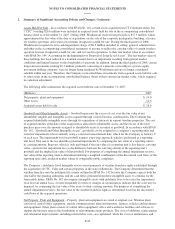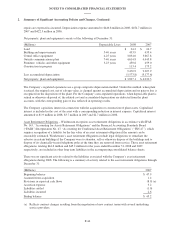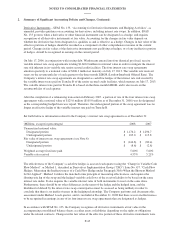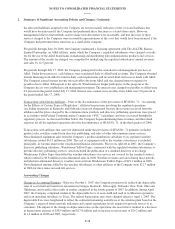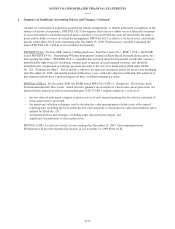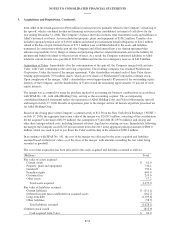Windstream 2008 Annual Report Download - page 138
Download and view the complete annual report
Please find page 138 of the 2008 Windstream annual report below. You can navigate through the pages in the report by either clicking on the pages listed below, or by using the keyword search tool below to find specific information within the annual report.
NOTES TO CONSOLIDATED FINANCIAL STATEMENTS
2. Summary of Significant Accounting Policies and Changes, Continued:
Recently Adopted Accounting Standards
Adoption of SFAS No. 162 - In the fourth quarter of 2008, Windstream adopted Statement of Financial
Accounting Standards (“SFAS”) No. 162, “The Hierarchy of Generally Accepted Accounting Principles”. SFAS
No. 162 identifies a consistent framework, or hierarchy, for selecting accounting principles to be used in preparing
financial statements for nongovernmental entities that are presented in conformity with generally accepted
accounting principles in the United States. The hierarchical guidance provided by SFAS No. 162 did not impact
the Company’s consolidated financial statements.
SFAS No. 157 - Effective January 1, 2008, Windstream adopted SFAS No. 157, “Fair Value Measurements”, for
financial assets and liabilities recognized at fair value. The adoption of SFAS No. 157 did not have a material
impact on our consolidated financial statements. SFAS No. 157 clarified the definition of fair value, established a
framework for measuring fair value and expanded the disclosures related to fair value measurements that are
included in a company’s financial statements. It emphasized that fair value is a market-based measurement and
not an entity-specific measurement, and that it should be based on an exchange transaction in which a company
sells an asset or transfers a liability. SFAS No. 157 also established a fair value hierarchy in which observable
market data would be considered the highest level, while fair value measurements based on an entity’s own
assumptions would be considered the lowest level. See Note 6 for information and related disclosures regarding
Windstream’s fair value measurements.
In February 2008, the Financial Accounting Standards Board (“FASB”) issued FASB Staff Position No. (“FSP”)
FAS 157-2, “Effective Date of FASB Statement No. 157”, which allowed a one-year deferral of implementation
for non-financial assets and liabilities, except items recognized or disclosed at fair value on an annual or more
frequently recurring basis until fiscal years beginning after November 15, 2008 and interim periods within those
years. The Company continues to evaluate the effects, if any, that SFAS No. 157 will have on its non-financial
assets and liabilities that are recognized or disclosed at fair value on a non-recurring basis. Therefore, it has not
yet been determined what impact, if any, that SFAS No. 157 will have on these assets and liabilities upon full
adoption.
Windstream adopted FSP FAS 157-3, “Determining the Fair Value of a Financial Asset When the Market for That
Asset Is Not Active”, effective July 1, 2008. FSP FAS 157-3 clarifies the application of SFAS No. 157 in an
inactive market by allowing companies to use judgment in addition to market information in certain circumstances
when valuing assets which have inactive markets. Additionally, FSP FAS 157-3 provides an example to illustrate
key considerations in determining the fair value of a financial asset in an inactive market. The adoption of this
FSP did not impact the Company’s fair value measurements during the third quarter of 2008. The Company is still
evaluating the impact of this FSP upon full adoption of SFAS No. 157.
SFAS No. 159 - Windstream adopted SFAS No. 159, “The Fair Value Option for Financial Assets and Financial
Liabilities – Including an Amendment of FASB Statement No. 115”, on January 1, 2008, but did not elect the fair
value option for any of its eligible financial assets and liabilities. Therefore, the adoption of SFAS No. 159 did not
impact the Company’s consolidated financial statements. SFAS No. 159 allowed the measurement at fair value of
eligible financial assets and liabilities that are not otherwise required to be measured at fair value. If the fair value
option for an eligible item is elected, unrealized gains and losses for that item are reported in current earnings at
each subsequent reporting date. SFAS No. 159 also established presentation and disclosure requirements designed
to draw comparison between the different measurement attributes the company elects for similar types of assets
and liabilities.
Adoption of FIN 48 - Windstream adopted the provisions of FASB Interpretation No. 48, Accounting for
Uncertainty in Income Taxes, on January 1, 2007. The adoption of FIN 48 resulted in no impact to either the
Company’s reserves for uncertain tax positions or to retained earnings. At the adoption date, the Company had
approximately $1.3 million of gross unrecognized tax benefits, all of which related to periods preceding the spin
off from Alltel. The Company is indemnified in accordance with a tax sharing agreement with Alltel dated
July 17, 2006 for reserves of approximately $1.3 million for uncertain tax positions that related to periods
preceding the spin off from Alltel. Consequently, a corresponding receivable from Alltel equaling the gross
unrecognized tax benefits plus accrued interest expense and penalties has been recognized.
F-50





